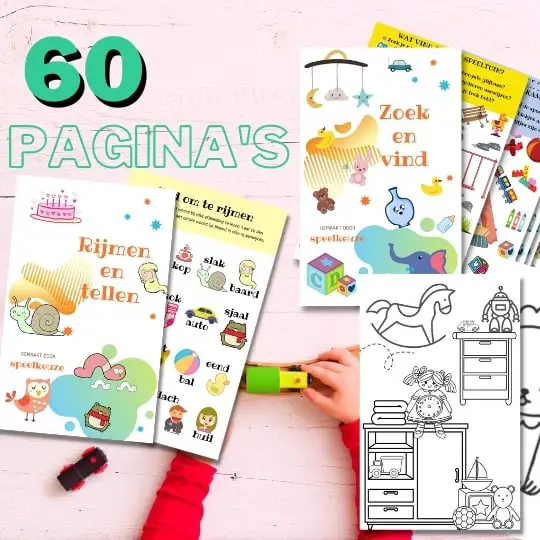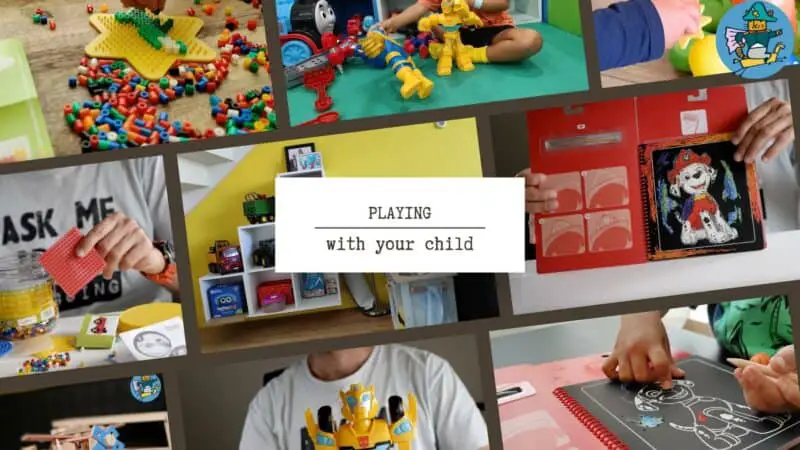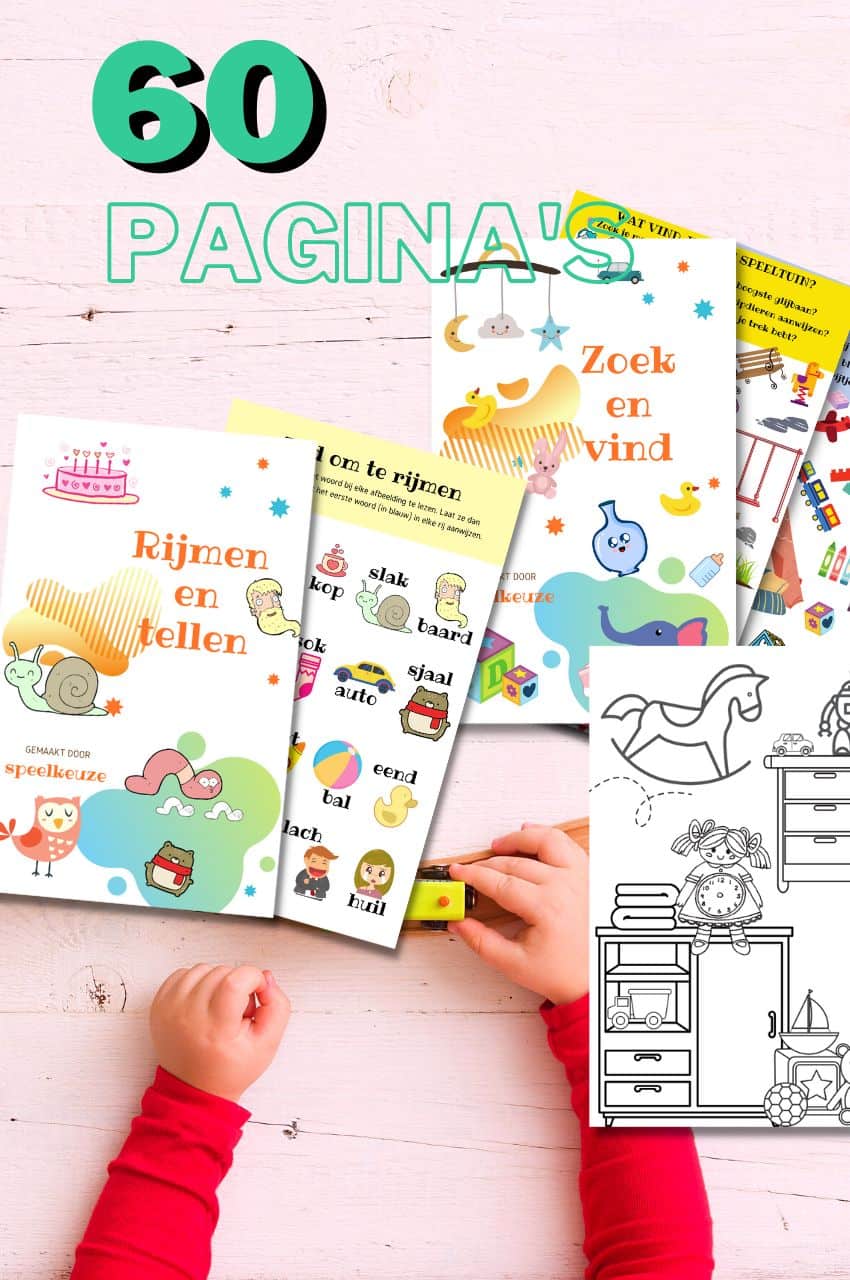Playing with your child as a family: The role of parents

Always something to do for the holidays or rainy day?
Play Choice now has the ultimate activity book collection, with over 60 pages of fun coloring pages and educational puzzles.

According to the Oxford dictionary, play is “engaging in activities for fun and relaxation rather than for any serious or practical reason”. Play is an essential part of learning, even if it has no serious or practical goals. It offers the opportunity to discover new things, have fun and develop positive social skills.
It's important to make time to play with your child and have fun together as a family.
Play evolves as the child grows, from baby to toddler to elementary school. It develops in different stages and offers opportunities to move, build and learn new skills. The type of play and the parent's role can help to get the most out of playtime.
Learning through play, the right environment and the right toys are also important for development. It stimulates creativity, improves communication and helps solve problems. It provides a safe space for children to grow and be themselves.

From toddler to toddler activity book collection
Educational games and coloring pages for 3 to 6 years
Your toddler and preschooler will love this e-book, along with the accompanying printables. He or she can play with it at every stage of development, together with mom and dad.
Buy at Bol.comWhat we discuss in this comprehensive post:
Why is play important?
Play is important because it gives children the opportunity to develop skills, learn and grow. It provides opportunities for physical activity, creativity and social interaction. Play contributes to the overall development of children and helps them to develop self-confidence, resilience and empathy.
It stimulates the brain and promotes cognitive and motor skills. Play also provides an outlet for stress and promotes relaxation and pleasure. Playing with your child and playing together as a family is important for strengthening bonds and fostering positive relationships.
The research by Riihelä (2002) showed that children learn social interaction patterns from an early age through their innate cooperation skills, zest for life and rich imagination.
So make time to play with your child and make sure the whole family plays together.
Why should you make time to play with your child?
Making time to play with your child is important because it has strong positive effects on your child's social, emotional and cognitive development. Play also strengthens the bond between parent and child, promotes self-confidence and offers relaxation and fun.
By playing together, you can resolve conflicts, stimulate the imagination and improve communication skills.
Play creates lasting memories and strengthens parental strengths and insights.
How can families play together?
Playing together as a family means that parents and siblings do activities together. According to McCreary & Dancy (2004), effective families provide emotional support, communicate, do things together, help each other, and raise children appropriately.
There are several ways families can play together, including board games, cooking, creative activities, and playing outside. It's important that the games are also fun for the parents.
Playing together provides opportunities for positive interactions, building strong bonds and creating shared experiences. It also stimulates creativity, social skills and exercise.
When do children learn to play together?
Playing together and socializing are crucial for children's development, but this does not always happen automatically. Around the age of 3 years children often start playing together, which helps with empathy, sharing and social insight. Team sports also contribute to their social-emotional development. As a parent you can encourage this with suitable games and by setting a good example yourself.
Playing together teaches children valuable skills such as sharing, empathy and conflict resolution, and it promotes their language and thinking development, as well as humor and imagination. These skills are important for their social competence and can help them become successful adults in a society where cooperation is essential.
Which games are also fun for parents?
Games that are also fun for parents include the following.
- Freeze Dance: This game involves players freezing their moves when the music stops. It's simple and requires focus, which adults enjoy.
- Pictionary: This game is all about drawing words and guessing them. It promotes teamwork and brings a lot of laughter.
- Hide and Seek: This classic game encourages children to hide while parents search for them. It promotes social interaction and is exciting for all ages.
- Scavenger Hunt: This interactive scavenger hunt can be adapted to different ages and promotes exploration and vocabulary enrichment.
- Hopscotch: This game, in which players jump over a series of numbered squares, promotes logical thinking and strategic decision-making.
- Charades: This game is all about acting out words or sentences without talking. It provides a lot of fun and promotes creativity and interaction.
This games are fun for children and parents and provide entertainment and promote the bond between parents and children.
How does play develop during childhood?
Play develops in different ways during childhood. In infants, it starts with simple movements and exploring toys. As children grow older, their play activities become more complex and focused on interacting with others. They play parallel to each other, ask questions, create and solve problems together.
Play also helps develop social skills, communication and attention. It's essential for the overall development of children.
What does infant playtime look like?
Infant playtime is an essential part of their development. In the first few months, babies are mainly concerned with exploring their environment and discovering their own body. They may be interested in grasping objects and making sounds.
While playing on their stomachs, it helps them strengthen their neck muscles and later learn to lift their heads. They can also make different sounds and spend a lot of time exploring toys.
As As babies grow and develop, their play activities become more varied. They can begin to observe their environment and engage in parallel play, where they play alongside other children without direct interaction.
What does preschool playtime look like?
Preschool playtime is a time when they are active, discovering new things and learning through play.
While playing, they use their imagination and creativity. They create new scenarios and come up with solutions for different situations. This helps them to develop their cognitive and social skills.
Preschoolers are often curious and interested in exploring the world around them. They're actively exploring new things and experimenting with different activities. This stimulates their sensory and motor development.
While playing with other children, they also learn social skills. They learn to work together, resolve conflicts and be involved in group activities, all because toddlers really enjoy playing. This helps them build friendships and develop emotionally.
Can preschoolers play together?
Yes, preschoolers are able to play together. A study by Göncü, A. (1993) entitled “Development of intersubjectivity in the dyadic play of preschoolers” shows that children's play becomes increasingly intersubjective during the preschool years.
Intersubjectivity is defined as a shared understanding established between players. The results of the study show that preschooler's social play is increasingly shared between 3 and 4 1/2 years old.
How do you get the most out of playtime?
To get the most out of playtime it's important to stimulate the child's imagination, provide a positive and supportive environment, encourage creativity and provide varied play options.
The type of play affects play time and the parent's role is to guide the play and follow the child's needs.
Quality playtime is important for playful learning and using the right toys can increase playtime by stimulating the child's imagination and creativity.
What are the types of play?
The main types of play are active play, imaginative play, social play and digital play.
Active play engages children in physical activities and helps them develop their motor skills. Imaginative play encourages children to use their imagination and learn new things by creating different roles and scenarios. Social play promotes social interaction and collaboration between children, while digital play enables children to learn and have fun using technology.
Elk type of game has its own advantages and helps children grow and learn in different ways.
What is the parent's role in play?
The role of the parent in play is crucial. They play a positive role by creating a space for play, providing appropriate materials and focusing on skills development. Parents encourage activities and provide support to children during play.
This helps children to develop their imagination and creativity in an unstructured way. Participating in the game strengthens the bond between parent and child and promotes a sense of autonomy.
Parents show genuine interest and provide a supportive environment where children can explore safely and develop their developmental skills at their own pace.
Why do adults stop playing with toys?
Adults stop playing with toys because their complex life offers little time and lack of interest. They stop looking for fun and focus on other things, such as work and family priorities.
Society sees playing with toys as childish and exerts pressure to conform to adult expectations. In addition, their interest shifts to other activities such as watching videos and hobbies that offer more challenge and stimulation.
This transition corresponds to the developmental phase from the teenage years to adulthood.
Why do I still enjoy playing with toys?
The opposite is also possible. Some people like to keep playing with toys. This can be for several reasons.
Play can reduce stress and provide relaxation. It brings a sense of joy and fun. Toys can also help stimulate the imagination and provide social interaction.
For some adults, playing with toys can also be a way to reminisce and create a sense of belonging. In addition, collecting toys can be a hobby that gives satisfaction.
Playing with toys also helps people avoid the pressures of societal expectations and maintain a sense of innocence.
What is play-based learning?
Play-based learning is an approach to learning that has play as its key role. It combines learning with fun and uses different forms of play to enable children to learn in a natural and loving way throughout their lives.
It provides a context in which children can choose how they want to learn and what role they want to take on. Game-based learning supports children's development through structured and unstructured activities and experiences.
This approach recognizes that children must be actively engaged and motivated to learn, and that they learn through meaningful interactions with their environment.
Why does the playing environment matter?
The play environment is important as it influences children's learning, play and development. Outdoor play provides the opportunity to interact with the natural world and develop key skills, while indoor play allows for organized activities and simulations.
Beide play environments are essential for development of children's emotional, social, physical and cognitive skills.
What are the advantages of toys for playing together?
Toys have several benefits when you use them for play together. Piaget's theory supports the importance of play in early education. Toys help develop skills such as problem solving, language development and spatial awareness, which promote cognitive growth. (“Designing Toys to Support Children's Development” – Page, T., & Thorsteinsson, G., 2017).
The three most important of the 9 benefits of playing with toys that it stimulates cognitive development, sparks creativity and helps build a bond with the family.
How do you use the right toys for playing together?
When playing together, it's important to have the right toys so you have quality playtime. Choose toys that promote learning, such as board games and building sets. Also toys that stimulate the imagination and senses, such as craft sets and sensory toys.
It's important to choose toys appropriate to the age and development of the child, and to rotate toys regularly to maintain interest and engagement.
In addition, it's important to actively supervise playtime and encourage critical thinking. In this way you create a play environment that supports the development of the child, promotes cooperation and imagination, and makes fun and bonding possible.
How do you ensure the right clothing sizes to play in?
Ensuring the correct clothing sizes for play can be important to ensure that the child can move and play comfortably without restrictions.
The most important thing is to measure your child properly with a measuring tape from the top of the head to the feet and don't forget the chest, waist and hips. This helps determine the correct size for shirts, pants and skirts.
Many clothing brands and stores have size charts available on their websites or in stores. These tables indicate which size is suitable for the measured length and circumference. Remember that clothing sizes may vary between different brands and manufacturers, so it's always a good idea to consult the specific size chart of the brand you're purchasing from. It is important to choose clothes that not only fit well, but are also suitable for the activities and weather in which the child will play.

Always something to do for the holidays or rainy day?
Play Choice now has the ultimate activity book collection, with over 60 pages of fun coloring pages and educational puzzles.
Joost Nusselder, the founder of Speelkeuze.nl is a content marketer, father and loves trying out new toys. As a child he came into contact with everything related to games when his mother started the Tinnen Soldaat in Ede. Now he and his team create helpful blog articles to help loyal readers with fun play ideas.